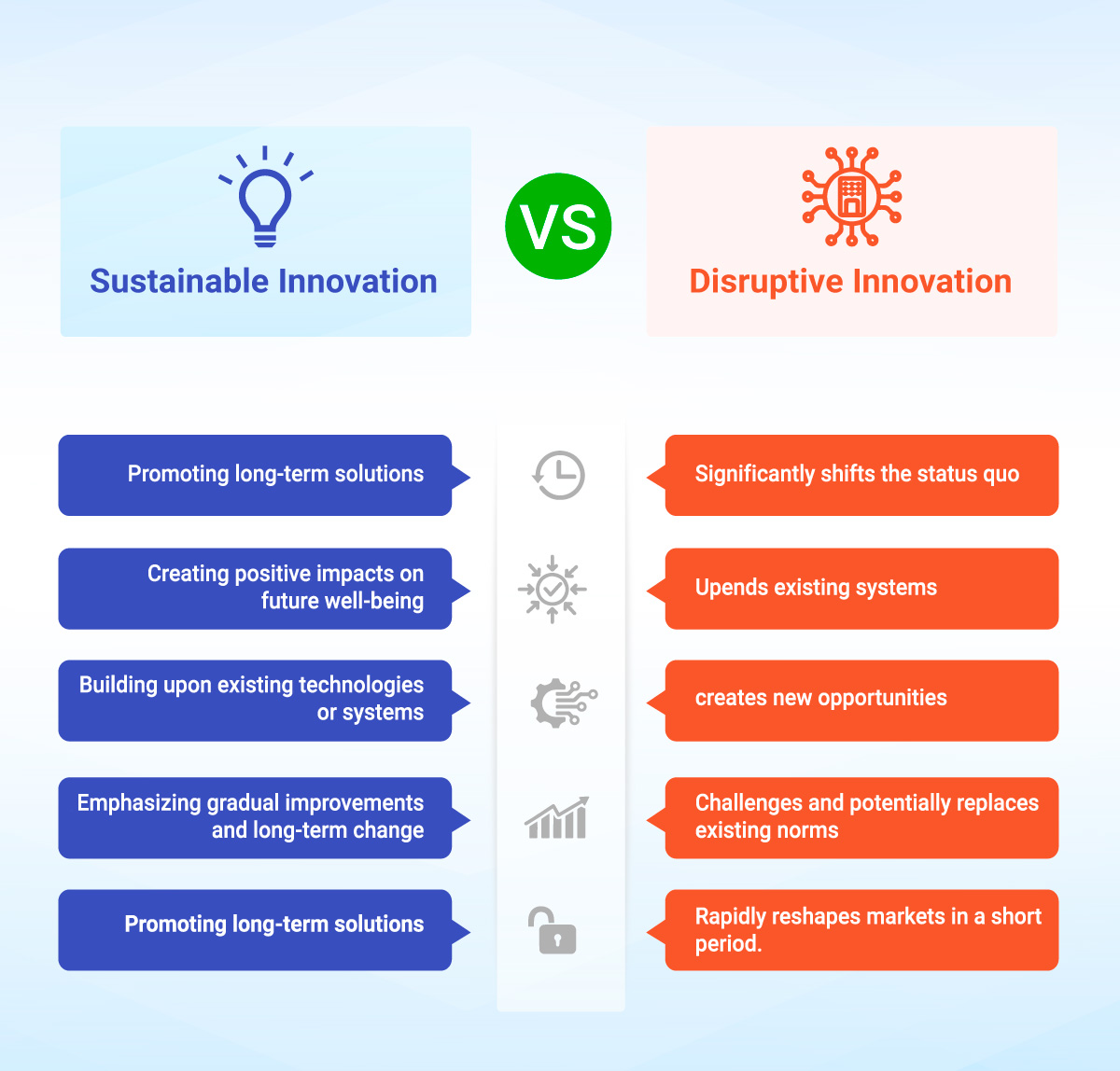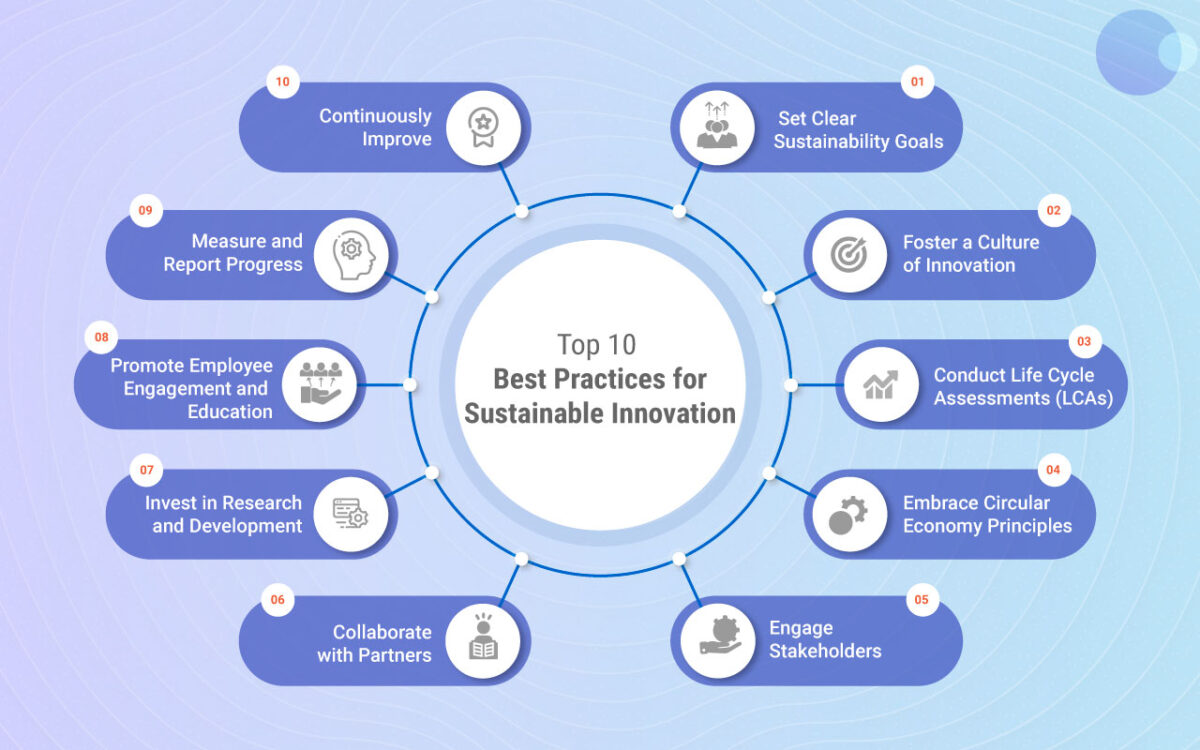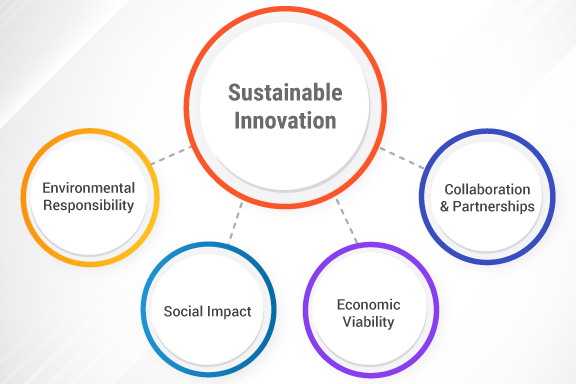Table of Contents
What is Sustainable Innovation?
Sustainable innovation is defined as the process of developing and implementing new products, services, technologies, or business models that have a positive environmental, social, and economic impact. It involves finding creative and efficient solutions to address pressing challenges, such as climate change, resource depletion, pollution, inequality, and poverty.
The goal of sustainable innovation is to meet the needs of the present generation without compromising the ability of future generations to meet their own needs. Here are some of the key characteristics of sustainable innovation:
- Environmental Responsibility: Sustainable innovation aims to reduce resource consumption, minimize waste and pollution, and mitigate negative impacts on ecosystems. It promotes the use of renewable energy, sustainable materials, and technological innovation.
- Social Impact: Sustainable innovation considers social equity, inclusivity, and the well-being of communities. It seeks to address social challenges, such as poverty, inequality, and access to education, healthcare, and clean water. It may involve developing products or services that improve the quality of life for underserved populations.
- Renewable Energy and Clean Technologies: Innovations in renewable energy sources, energy storage, and energy efficiency are crucial components of sustainable innovation. These technology innovations aim to reduce reliance on fossil fuels and mitigate climate change.
- Economic Viability: Sustainable innovation recognizes the importance of economic sustainability. It strives to create value and generate economic benefits while ensuring long-term profitability. This can be achieved through cost savings, market opportunities, increased efficiency, and the development of new markets.
- Innovative Business Models: Sustainable innovation may involve a business model innovation that emphasize sharing, access over ownership, and the creation of value through sustainable practices. Examples include ride-sharing services, renewable energy subscription models, and product-as-a-service concepts.
- Collaboration and Partnerships: Sustainable innovation often requires collaboration among various stakeholders, including businesses, governments, NGOs, research institutions, and local communities. Partnerships enable the pooling of resources, knowledge, and expertise to drive sustainable solutions at a larger scale.
Learn more: What is Continuous Innovation?
Sustainable Innovation VS Disruptive Innovation

While there are distinct differences between sustainable and disruptive innovation, it’s important to note that they are not mutually exclusive. In fact, sustainable innovation can also be disruptive in nature. For example, the development and widespread adoption of renewable energy technologies have disrupted the traditional energy sector, challenging the dominance of fossil fuels. Sustainable innovation can bring about disruptive changes by challenging existing practices, technologies, and business models in order to create more sustainable alternatives.
The key distinction lies in the primary focus, purpose, and overall approach toward innovation:
- Key Focus Areas: Sustainable innovation aims to address environmental, social, and economic challenges by developing and implementing solutions that promote long-term sustainability. Disruptive innovation, on the other hand, targets established industries or markets by introducing new products, services, or business models that create a significant shift in the status quo.
- Approach: Sustainable innovation often builds upon existing technologies, systems, or practices and seeks to improve them in a way that minimizes negative impacts and maximizes positive outcomes. Whereas, disruptive innovation often involves radical or breakthrough ideas, technologies, or approaches that challenge and potentially replace existing norms, practices, or products.
- Purpose/Goal: The primary goal of sustainable innovation is to create positive impacts and ensure the well-being of current and future generations. Disruptive innovation‘s main goal is always to upend existing systems, challenge conventional thinking, and create new opportunities and market dynamics.
- Timeframe for Innovation: Sustainable innovation tends to be incremental and evolutionary, focusing on gradual improvements and long-term change. Disruptive innovation typically occurs relatively quickly, disrupting established industries and reshaping markets within a short period.
Some examples of sustainable innovation are: the development of energy-efficient technologies, implementation of waste reduction strategies, the promotion of sustainable agriculture practices, and the integration of social responsibility into innovative business models are examples of sustainable innovation.
Examples of disruptive innovation are the introduction of personal computers in the late 1980s, digital photography replacing film photography, online streaming services replacing DVDs, and quite recently, cab-booking mobile apps.
Learn more: What is Discontinuous Innovation?
Key Examples of Sustainable Innovation
Examples of sustainable innovation include:
- Renewable Energy Technologies: The development and implementation of technology innovations such as solar power, wind power, hydropower, and other clean energy sources to reduce dependence on fossil fuels and mitigate climate change.
- Circular Economy Practices: Designing products for durability, repairability, and recyclability, and implementing strategies to minimize waste, extend product lifecycles, and promote the reuse and recycling of materials.
- Sustainable Agriculture: Applying innovative techniques, such as precision farming, organic farming, agroecology, and vertical farming, to promote sustainable food production, reduce resource consumption, and protect biodiversity.
- Sustainable Transportation: Developing electric vehicles, improving public transportation systems, and promoting alternative fuels and mobility solutions to reduce greenhouse gas emissions and air pollution.
- Social Enterprises: Creating businesses with a social mission, such as fair trade organizations, microfinance institutions, and companies focused on providing access to clean water, affordable housing, or education in underserved communities.
Top 10 Best Practices for Sustainable Innovation

Here are some best practices for sustainable innovation that can help guide organizations and individuals in their efforts to create positive environmental, social, and economic impacts:
1. Set Clear Sustainability Goals
Define specific and measurable sustainability goals that align with your organization’s values and priorities. These goals can serve as guiding principles for sustainable innovation efforts.
2. Foster a Culture of Innovation
Cultivate an organizational culture of innovation that encourages and supports innovation. Promote open innovation, communication, collaboration, and a willingness to take risks and learn from failures. Encourage employees at all levels to contribute their ideas and provide the necessary resources for experimentation and exploration.
3. Conduct Life Cycle Assessments (LCAs)
Use life cycle assessments to evaluate the environmental impacts of products, services, or processes throughout their entire life cycle. This assessment helps identify areas for improvement and informs decision-making toward more sustainable alternatives.
4. Embrace Circular Economy Principles
The transition from a linear “take-make-dispose” model to a circular economy approach that focuses on reducing waste, promoting reuse and recycling, and designing products for longevity and resource efficiency.
5. Engage Stakeholders
Involve stakeholders, including customers, employees, suppliers, local communities, and NGOs, in the sustainable innovation process. Seek their input, listen to their perspectives, and collaborate on finding sustainable solutions that meet their needs and expectations.
6. Collaborate with Partners
Form partnerships and collaborations with other organizations, research institutions, and governmental bodies to leverage collective knowledge, resources, and expertise. Collaborative efforts can accelerate sustainable innovation and facilitate systemic change.
7. Invest in Research and Development
Allocate resources for research and development initiatives focused on sustainable technologies, processes, and business models. Foster innovation by supporting research that tackles environmental and social challenges and drives sustainable solutions.
8. Promote Employee Engagement and Education
Provide training and educational opportunities to employees to raise awareness and enhance understanding of sustainability issues and opportunities. Encourage employees to contribute their ideas and empower them to take ownership of sustainability initiatives within the organization.
9. Continuously Improve
Foster a culture of continuous innovation by regularly reviewing and reassessing sustainable innovation efforts. Learn from successes and failures, seek feedback from stakeholders, and adapt strategies and approaches as needed to drive ongoing progress.
10. Measure and Report Progress
Establish metrics and key performance indicators (KPIs) to track progress toward sustainability goals. Regularly report on sustainability performance, both internally and externally, to demonstrate transparency and accountability.
By implementing these best practices, organizations and individuals can enhance their ability to innovate in a sustainable manner, contributing to a more resilient and equitable future.
Learn more: What is Process Innovation?
Most Recent Posts
Explore the latest innovation insights and trends with our recent blog posts.













